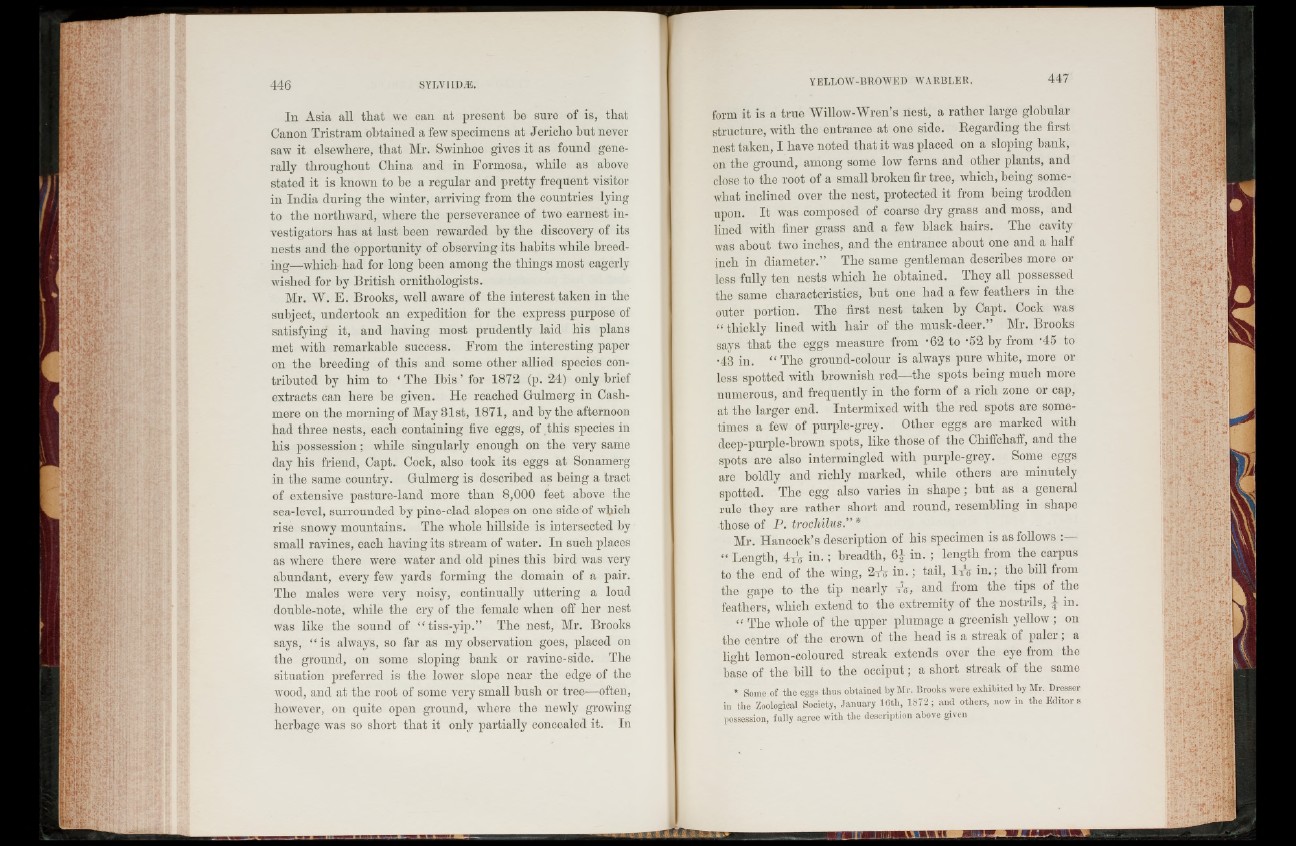
In Asia all that we can at present be sure of is, that
Canon Tristram obtained a few specimens at Jericho but never
saw it elsewhere, that Mr. Swinhoe gives it as found generally
throughout China and in Formosa, while as above
stated it is known to be a regular and pretty frequent visitor
in India during the winter, arriving from the countries lying
to the northward, where the perseverance of two earnest investigators
has at last been rewarded by the discovery of its
nests and the opportunity of observing its habits while breeding—
which had for long been among the things most eagerly
wished for by British ornithologists.
Mr. W. E. Brooks, well aware of the interest taken in the
subject, undertook an expedition for the express purpose of
satisfying it, and having most prudently laid his plans
met with remarkable success. From the interesting papelón
the breeding of this and some other allied species contributed
by him to ‘ The Ibis ’ for 1872 (p. 24) only brief
extracts can here be given. He reached Gulmerg in Cash-
mere on the morning of May 31st, 1871, and by the afternoon
liad three nests, each containing five eggs, of this species in
his possession; while singularly enough on the very same
day his friend, Capt. Cock, also took its eggs at Sonamerg
in the same country. Gulmerg is described as being a tract
of extensive pasture-land more than 8,000 feet above the
sea-level, surrounded by pine-clad slopes on one side of which
rise snowy mountains. The whole hillside is intersected by
small ravines, each having its stream of water. In such places
as where there were water and old pines this bird was very
abundant, every few yards forming the domain of a pair.
The males were very noisy, continually uttering a loud
double-note, while the cry of the female when off her nest
was like the sound of “ tiss-yip.” The nest, Mr. Brooks
says, “ is always, so far as my observation goes, placed on
the ground, on some sloping bank or ravine-side. The
situation preferred is the lower slope near the edge of the
wood, and at the root of some very small bush or tree—often,
however, on quite open ground, where the newly growing
herbage was so short that it only partially concealed it. In
form it is a true Willow-Wren’s nest, a rather large globular
structure, with the entrance at one side. Regarding the first
nest taken, I have noted that it was placed on a sloping bank,
on the ground, among some low ferns and other plants, and
close to the root of a small broken fir tree, which, being somewhat
inclined over the nest, protected it from being trodden
upon. I t was composed of coarse dry grass and moss, and
lined with finer grass and a few black hairs. The cavity
was about two inches, and the entrance about one and a half
inch in diameter.” The same gentleman describes more or
less fully ten nests which he obtained. They all possessed
the same characteristics, but one had a few feathers in the
outer portion. The first nest taken by Capt. Cock was
“ thickly lined with hair of the musk-deer.” Mr. Brooks
says that the eggs measure from -62 to -52 by from -45 to
•43 in. “ The ground-colour is always pure white, more or
less spotted with brownish red—the spots being much more
numerous, and frequently in the form of a rich zone or cap,
at the larger end. Intermixed with the red spots are sometimes
a few of purple-grey. Other eggs are marked with
deep-purple-brown spots, like those of the Cliiffchail, and the
spots are also intermingled with purple-grey. Some eggs
are boldly and richly marked, while others are minutely
spotted. The egg also varies in shape ; but as a general
rule they are rather short and round, resembling in shape
those of P. trochilus.” *
Mr. Hancock’s description of his specimen is as follows
“ Length, 4TV in. ; breadth, 6^ in. ; length from the carpus
to the end of the wing, 2tV in .; tail, I tt in.; the bill fiom
the gape to the tip nearly tV, and from the tips of the
feathers, which extend to the extremity of the nostrils, £ in.
“ The whole of the upper plumage a greenish yellow ; on
the centre of the crown of the head is a streak of p a le i, a
light lemon-coloured streak extends over the eye from the
base of the bill to the occiput ; a short streak of the same
* Some of tlie eggs thus obtained by Mr. Brooks were exhibited by Mr. Dresser
in the Zoological Society, January lOtli, 1372 ; and others, now in the Editor s
possession, fully agree with the description above given